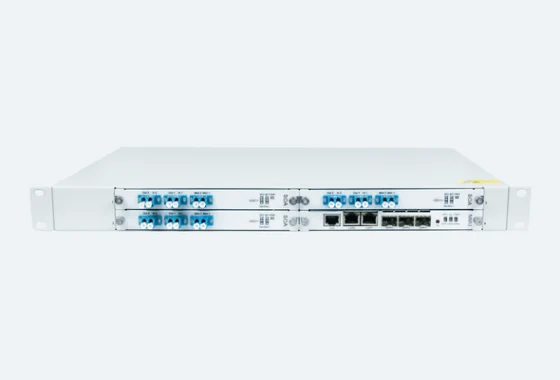- This topic is empty.
-
AuthorPosts
-
05/09/2024 at 18:51 #152182
In the dynamic field of optical communications, the quest for faster data transmission and increased network capacity has spurred numerous technological innovations. Among these advancements, the 100G SOA (Semiconductor Optical Amplifier) stands out as a game-changer. This article WDMLight explores the 100G SOA amplifier in detail, focusing on its advantages in shaping the future of optical communication systems.
What are 100G SOA Amplifiers?

A 100G SOA amplifier is a type of semiconductor optical amplifier specifically designed to operate at 100 gigabits per second (Gbps). SOAs are essential in optical communication systems for amplifying signals without converting them to electrical signals. This amplification is crucial for maintaining signal quality over long distances and through various network components.
The 100G SOA amplifier is designed to handle data rates of 100 Gbps, which requires advanced semiconductor materials and precise engineering to achieve high-speed amplification. The amplifier's performance is influenced by factors such as gain, noise figure, and saturation power, all of which are crucial for ensuring high-quality signal amplification in optical networks.
Advantages of 100G SOA Amplifiers in Optical Networks
The 100G SOA amplifier offers several compelling advantages that make it a preferred choice in high-speed optical communication systems. These benefits stem from the amplifier's design and its ability to meet the demanding requirements of modern networks.
1. High-Speed Performance
The primary advantage of the 100G SOA amplifier is its ability to support high-speed data transmission. Operating at 100 Gbps, this amplifier can handle the increasing data rates required by contemporary applications such as high-definition video streaming, cloud computing, and real-time data analytics. The high-speed performance ensures that large volumes of data can be transmitted quickly and efficiently, enhancing the overall performance of optical networks.
The ability to maintain signal integrity at such high speeds is crucial for minimizing data loss and ensuring reliable communication. The 100G SOA amplifier's design is optimized to handle high-speed signals without introducing significant distortion or attenuation, making it a key component in achieving high-performance optical networks.
2. Compact and Cost-Effective
Compared to other optical amplifiers, such as erbium-doped fiber amplifiers (EDFAs), the 100G SOA amplifier is relatively compact and cost-effective. The use of semiconductor materials in SOAs is less expensive than the rare-earth dopants used in EDFAs, which helps reduce the overall cost of the amplifier. Additionally, the small size of SOA components allows for easier integration into optical systems, saving valuable space and reducing installation complexity.
The cost-effectiveness of 100G SOA amplifiers is particularly advantageous for large-scale network deployments, where minimizing equipment costs is essential. The combination of high performance and affordability makes the 100G SOA amplifier an attractive option for a wide range of optical communication applications.
3. Broad Wavelength Range
Another notable advantage of the 100G SOA amplifier is its ability to amplify signals across a broad wavelength range. This feature is important for wavelength-division multiplexing (WDM) systems, which transmit multiple data streams on different wavelengths of light. The broad wavelength range of the 100G SOA amplifier allows it to support multiple channels simultaneously, enhancing the capacity and efficiency of the network.
The flexibility to handle various wavelengths enables the 100G SOA amplifier to be used in diverse optical networks, including those that require the simultaneous transmission of multiple channels. This versatility contributes to the overall scalability and performance of the network, making it a valuable component in modern optical communication systems.
4. Low Noise Figure
The noise figure of an amplifier is a critical parameter that indicates the amount of noise introduced into the signal during amplification. A low noise figure is essential for maintaining signal quality and minimizing errors in data transmission. The 100G SOA amplifier is designed to have a low noise figure, which helps ensure that the amplified signal remains clear and free from distortion.
The low noise figure of 100G SOA amplifiers is achieved through careful design and optimization of the semiconductor materials and amplifier components. By minimizing noise, the 100G SOA amplifier contributes to the overall reliability and performance of optical communication systems, ensuring that data is transmitted accurately and efficiently.
5. High Gain Efficiency
Gain efficiency refers to the amplifier's ability to provide effective amplification with minimal power consumption. The 100G SOA amplifier is engineered to deliver high gain efficiency, which means it can amplify signals effectively while consuming less power. This efficiency is beneficial for reducing the overall energy consumption of optical networks and lowering operational costs.
The high gain efficiency of 100G SOA amplifiers is achieved through advanced design techniques and the use of high-quality semiconductor materials. By optimizing the gain performance and minimizing power consumption, the 100G SOA amplifier contributes to the sustainability and cost-effectiveness of optical communication systems.
The 100G SOA amplifier represents a major advancement in optical communication technology, offering high-speed performance, compact design, and cost-effectiveness. Its ability to operate at 100 gigabits per second makes it an essential component in modern optical networks, supporting a wide range of applications from long-haul transmission to data center interconnects.As technology continues to advance, the development of 100G SOA amplifiers is likely to see further improvements in performance, efficiency, and integration. Ongoing research and innovation in semiconductor materials, packaging, and cooling techniques will contribute to even more capable and versatile amplifiers, driving the evolution of high-speed optical communication systems.
The future of 100G SOA amplifiers holds promise for continued advancements in optical communication technology. By addressing the challenges of high-speed data transmission and network capacity, these amplifiers will play a crucial role in shaping the future of global communication networks and supporting the ever-growing demands of the digital age.
https://www.wdmlight.com/40G-100G-SOA-Amplifier.html
http://www.wdmlight.com
WDMLight -
AuthorPosts
- You must be logged in to reply to this topic.